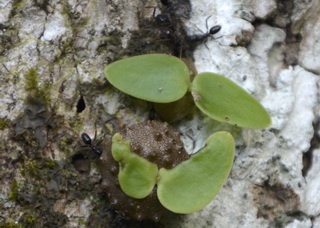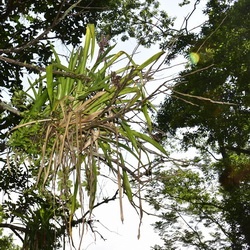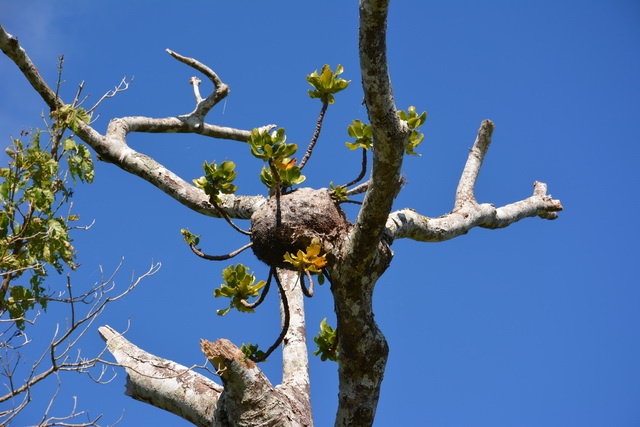Some arboreal ants grow useful plants
Gardening is an art – and there are ants that master this art. On the branches of trees they cultivate plants to live in or to strengthen their nests, as research teams of Guillaume Chomicki and Jonas Morales-Linares report.
Many ants and plants are partners in a mutualism: the plants provide the ants with a place to live or with nectar, and the ants deposit their droppings as fertilizer or protect the plants from herbivorous insects. Some tropical arboreal ants go a step further and cultivate the plants they live with. As these plants grow upon tree branches (they are epiphytes), it is more difficult for them to obtain nutrients than it is for plants that root in the soil, so the ant-plant mutualism is a good strategy. Many of the ant-grown plants are completely domesticated and would perish without the ants.
Seed collection
Philidris nagasau, native to Fiji, inhabits the hollow stems of Squamellaria species, bulb-shaped plants that grow on trees. The ants live nowhere else, and six Squamellaria species are always inhabited by these residents. The ant fertilizes the plants, as Guillaume Chomicki and colleagues had previously shown.
 Now, they discovered that the ant makes sure that plants are available by farming them. The researchers observed ant workers collecting exclusively the seeds of these six Squamellaria-species, and not those of any other species. They take them out of the unripe fruits, insert them in fissures and cracks in the bark of a tree and patrol the planting sites. Soon after, the seeds germinate and seedlings appear on the tree, and as soon as they form a cavity, a few ants will enter it, likely to leave their droppings. By doing so, they grow the plants they need to live in.
Now, they discovered that the ant makes sure that plants are available by farming them. The researchers observed ant workers collecting exclusively the seeds of these six Squamellaria-species, and not those of any other species. They take them out of the unripe fruits, insert them in fissures and cracks in the bark of a tree and patrol the planting sites. Soon after, the seeds germinate and seedlings appear on the tree, and as soon as they form a cavity, a few ants will enter it, likely to leave their droppings. By doing so, they grow the plants they need to live in.
So, this ant-plant mutualism is more intimate than previously thought. The plants need the ant partner not only for nutrition, but also for seed dispersal.
Beautiful flowers
A different kind of plant nurseries can be found in Central and South America: conspicuous little gardens that hang from some trees. They are the overgrown carton nests of certain ant species. The ants collect seeds of epiphytes and insert them in the walls of their nest, where of the seeds germinate and grow up. The plant roots strengthen the nest and take up water when it rains, so that the nests don’t disintegrate. In return, the ants fertilize the plants and protect them against herbivorous insects. Some plants are exclusively dispersed by the ants and only germinate in an ant nest.
 Azteca gnava from southern Mexico and Panama is such a gardening ant. His gardens are frequently found in plantations, as Jonas Morales-Linares and colleagues report, mostly on cocoa, mango, sapote and orange trees. The gardens contain twelve plants on average, typically of two or three different species. Two plant species that cannot live outside these gardens are the bromeliad Aechmea tillandsioides and the orchid Coryanthes picturata. Apparently, the gardening ants have a good taste, for these plants have beautiful flowers.
Azteca gnava from southern Mexico and Panama is such a gardening ant. His gardens are frequently found in plantations, as Jonas Morales-Linares and colleagues report, mostly on cocoa, mango, sapote and orange trees. The gardens contain twelve plants on average, typically of two or three different species. Two plant species that cannot live outside these gardens are the bromeliad Aechmea tillandsioides and the orchid Coryanthes picturata. Apparently, the gardening ants have a good taste, for these plants have beautiful flowers.
Three million years
The ant Camponotus femoratus of the Amazonian lowland forest plants similar gardens. Mutualism is obligate for the plant Peperomia macrostachya, that only lives in the nests of this ant. Elsa Youngsteadt and colleagues showed that Camponotus femoratus is the only ant species to collect the seeds of this plant. The ant takes them from the plant, from the soil or from the feces of birds and mammals that have eaten the fruits. Probably, the seeds emit volatiles that only only Camponotus femoratus appreciates. The ant inserts many Peperomia seeds in the walls of its nest. Each seed has only a small chance to germinate there, but the seeds that are not brought into the ant’s nests have no chance to sprout at all.
According to Chomicki, Philidris nagasau in Fiji descends from ancestors that, just like their American colleagues, made carton nests in trees and planted seeds in the wall. But at some time, Philidris nagasau stopped making nests and planted the seeds in the bark instead; at roughly the same time Squamellaria species developed the hollow, bulbous stems that can house the ants. So, ant and plants co-evolved; their co-evolution started about three million years ago.
Willy van Strien
Photo’s:
Large: a Squamellaria major plant, grown by ants on macaranga. © Guillaume Chomicki
Small 1: workers of Philidris nagasau inspecting seedlings. © Guillaume Chomicki
Small 2: hanging garden of Azteca gnava. © Jonas Morales-Linares
Sources:
Chomicki, G. & S.S. Renner, 2016. Obligate plant farming by a specialized ant. Nature Plants 2: 16181. Doi: 10.1038/nplants.2016.181
Chomicki, G., Y.M. Staedler, J. Schönenberger & S.S. Renner, 2016. Partner choice through concealed floral sugar rewards evolved with the specialization of ant-plant mutualisms. New Phytologist, online May 9. Doi: 10.1111/nph.13990
Morales-Linares, J., J.G. García-Franco, A. Flores-Palacios, J.E. Valenzuela-González, M. Mata-Rosas & C. Díaz-Castelazo, 2016. Vascular epiphytes and host trees of ant-gardens in an anthropic landscape in southeastern Mexico. The Science of Nature 103: 96. Doi: 10.1007/s00114-016-1421-9
Youngsteadt, E., J. Alvarez Baca, J. Osborne & C. Schal, 2009. Species-specific seed dispersal in an obligate ant-plant mutualism. PLoS ONE 4: e4335. Doi: 10.1371/journal.pone.0004335
